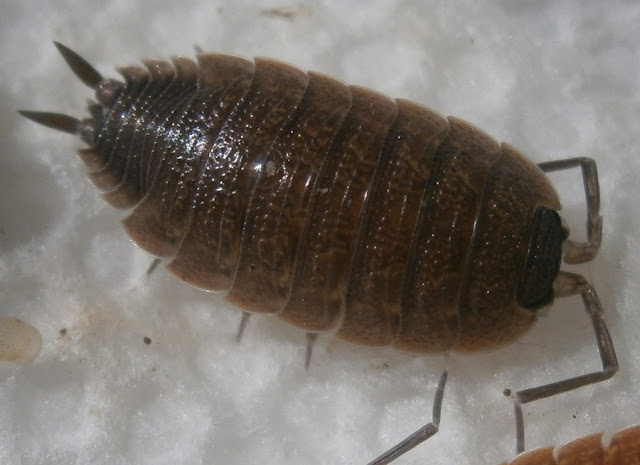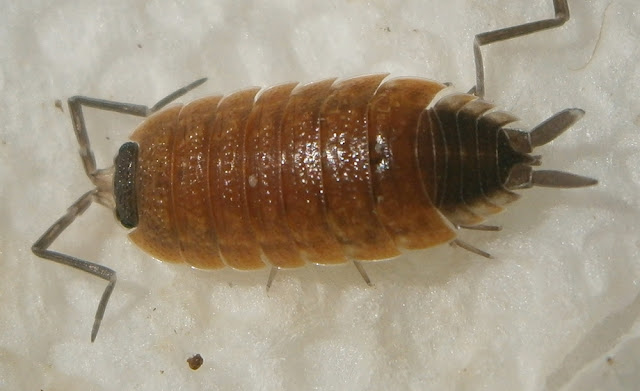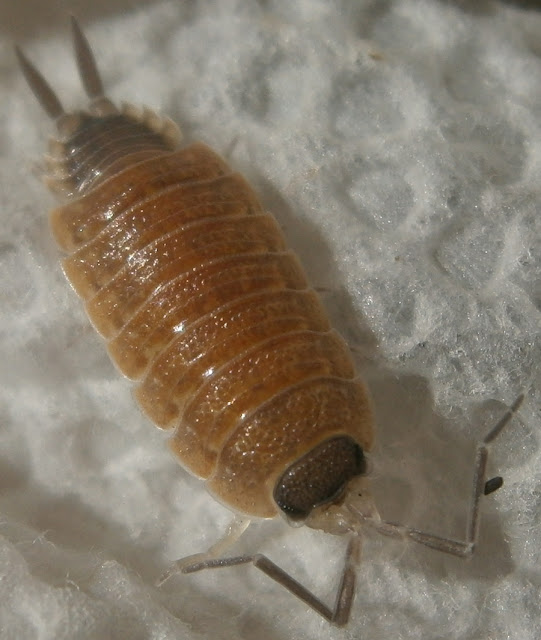My Arenivaga cf. genitalis are doing very well, my female is really plumping up, I assume because she is gravid. :) Haven't witnessed her laying an ootheca yet, but hopefully she will soon, or has already done so when I wasn't looking.
Anyway, I took a couple pictures of her the other day, here they are:
Here's hoping I'll have as much success with breeding these as I have with my A.bolliana! :)
Lately my Cariblatta minima haven't been doing so well, lots of adults have been dying, and some of the live adults and nymphs were biting their antennae and acting sickly. I rehoused them to a new enclosure with fresh substrate and new hides, and they seem to be doing much better! Their original enclosure was getting a little dirty, there were a couple generations' worth of frass and dead bodies on top of the original substrate, and they may have been just a little overcrowded, so that must have been why they were doing poorly.
At first I thought it was some sort of fungal infection, so I asked Alan Jeon what I should do. He said that if it was a fungal infection, I should find and remove all viable oothecae I could, put them in a clean container, then take out any nymphs that hatch and quickly move them to their own clean enclosure, to make sure that they wouldn't be infected with the fungus. He also suggested that I take a few females and put them each in their own little deli cups, so that I could easily find and remove any oothecae they lay.
Luckily that all seems to be unnecessary, since re-housing my culture seemed to fix the problem, but just in case, I did separate all the ooths I could find, and also separated 5 females, just in case my culture is infected with a fungus after all...
Here are a couple pictures I took of an adult female, (one of the ones I separated to their own enclosures):
It's a very nice little species, and I'm glad I was, (seemingly) able to solve the problem they were having before it was too late, as I think I'm one of the two people culturing this species at the moment, would be a shame to lose my colony.
Unfortunately, I am down to 16 Drymaplaneta nymphs, I accidentally smashed a couple while lifting their hide, and several more dropped dead for seemingly no reason. It may have gotten a bit stagnant in their enclosure, which could have been what killed them, since they abhor such conditions, however it wasn't that stagnant, so I'm not sure. Nonetheless, I have added more ventilation and am keeping them less humid, so far there haven't been any deaths since then...
I also added some bark to the enclosure to cover up the sandy substrate a bit, Kyle suggested I do so, since sand can be abrasive to the exoskeleton of roaches. Plus, it will provide better hides for the springtails I have added to their enclosure, in my experience springtails do best in cages with bark in them.
A few of the nymphs have made it to L3 already, which is great! I'm hoping that as they grow they will get hardier, otherwise it's unlikely that any of them will make it to adulthood...
I took some pictures of a few nymphs the other day, including an L3, here they are:
I really hope that I'll be able to breed these, they are probably the most difficult and fragile species in my collection at the moment, really want to get them established in culture here!
Anyway, that's gonna do it for today, I hope that everyone enjoyed this post, and I'll see you all next time! :)
Friday, March 31, 2017
Saturday, March 25, 2017
My New Anallacta methanoides Ootheca! (Edited)
I just got an ootheca (2 actually, though one sadly got crushed during the trip over here), of this lovely species from a good friend of mine, Sebastien Marcaillou, I'm very happy to have an ootheca from this unique species, and I'm really hoping that I can help to establish them in culture in the US again, as apparently all the other colonies here have died out.
I have it housed in a small sized plastic container with coconut fiber as the substrate, which I am trying to keep semi-moist, and have bark pieces and dead leaves as hides. I will be feeding the resulting nymphs, (should I get any) dog food and veggies.
Here are some pictures of the ootheca:
Really hoping that the ootheca will hatch and that the nymphs will do well for me, I would really love for this species to be established in the US hobby again, it's such a unique and interesting Ectobiid!
Well, that's going to be it for this post, I hope you guys enjoyed, it's very rare that I post two days in a row, but I really didn't want to wait any longer to share this great news! Anyways, I'll see you all next time! :)
EDIT: Well unfortunately this ooth turned out to be a dud, after a few hours of being in a moist enclosure the seam down the middle loosened up and revealed that the insides were black and rotten. :(
Don't know if it died during shipping or if it was just an infertile ooth, either way I won't be getting any nymphs from it unfortunately. Oh well, will just have to try again later I suppose, just goes to show, don't judge an ooth by it's outer appearance, because while it may look healthy, it could be dead inside! (Like all my Dorylaea orini ooths....).
I have it housed in a small sized plastic container with coconut fiber as the substrate, which I am trying to keep semi-moist, and have bark pieces and dead leaves as hides. I will be feeding the resulting nymphs, (should I get any) dog food and veggies.
Here are some pictures of the ootheca:
 |
| And some pics of the enclosure |
Really hoping that the ootheca will hatch and that the nymphs will do well for me, I would really love for this species to be established in the US hobby again, it's such a unique and interesting Ectobiid!
Well, that's going to be it for this post, I hope you guys enjoyed, it's very rare that I post two days in a row, but I really didn't want to wait any longer to share this great news! Anyways, I'll see you all next time! :)
EDIT: Well unfortunately this ooth turned out to be a dud, after a few hours of being in a moist enclosure the seam down the middle loosened up and revealed that the insides were black and rotten. :(
Don't know if it died during shipping or if it was just an infertile ooth, either way I won't be getting any nymphs from it unfortunately. Oh well, will just have to try again later I suppose, just goes to show, don't judge an ooth by it's outer appearance, because while it may look healthy, it could be dead inside! (Like all my Dorylaea orini ooths....).
Friday, March 24, 2017
Arenivaga bolliana Update
A few days ago, I was checking up on my Arenivaga bolliana enclosure, and I saw something small moving through the substrate. Upon closer examination, it turned out to be a tiny little Arenivaga hatchling! A quick search through the substrate revealed several more nymphs. Looks like I have successfully bred this species, this is the first time I have gotten offspring from a member of this genus, and I'm very happy about it!
Anyway, here are some pictures of the little cuties:
Really hope they'll grow well for me, I love this species, it's like a mini native Polyphaga! (In fact large females of this species are about the same size as smaller P.aegyptiaca females).
Anyway, I hope you guys enjoyed this post, I'll see you all next time! :)
Anyway, here are some pictures of the little cuties:
Really hope they'll grow well for me, I love this species, it's like a mini native Polyphaga! (In fact large females of this species are about the same size as smaller P.aegyptiaca females).
Anyway, I hope you guys enjoyed this post, I'll see you all next time! :)
Wednesday, March 22, 2017
My New Porcellio silvestrii!!
Today I received my end of a trade with Alan Grosse, owner of this lovely isopod store here, and the guy who I sold some of my original "Pied" Cylisticus convexus to. I traded some of my Oniscus asellus "Mardi Gras Dalmatian" (yes, that's what I'm calling them), for some of his Porcellio silvestrii. They all arrived safe and sound, and though I only traded for eight, he sent a freebie as well. :)
This species has a grey and an orange morph, with some individuals displaying coloration of both, however the coloration seems to be random and apparently can not be isolated. P.silvestrii likes it drier than most of the more commonly kept isopod species, as is normal for the Spanish Porcellio species, the enclosure should be fairly dry with a moist spot for them to retreat to. This is one of the easiest to breed species from Spain, and is great for practicing the care needs of the rarer species like Porcellio bolivari and Porcellio magnificus.
Here are some pictures of them:
Really excited to have this species in my collection, hopefully I'll be able to breed them without too much trouble, then I can maybe branch off into the rarer species like P.bolivari!
Anyway, that's gonna be it for today, I hope you guys enjoyed this post, and I'll see you all next time! :)
This species has a grey and an orange morph, with some individuals displaying coloration of both, however the coloration seems to be random and apparently can not be isolated. P.silvestrii likes it drier than most of the more commonly kept isopod species, as is normal for the Spanish Porcellio species, the enclosure should be fairly dry with a moist spot for them to retreat to. This is one of the easiest to breed species from Spain, and is great for practicing the care needs of the rarer species like Porcellio bolivari and Porcellio magnificus.
Here are some pictures of them:
 |
| And here is their enclosure |
Anyway, that's gonna be it for today, I hope you guys enjoyed this post, and I'll see you all next time! :)
Wednesday, March 15, 2017
My New Compsodes schwarzi & Parcoblatta caudelli!
Today I got my end of a trade with Alan Jeon, (AKA Cariblatta lutea on the Allpet roaches forum), I got a group of about 10 Compsodes schwarzi, a really small native roach species in the family Corydiidae, and the only member of it's genus in the hobby, and he also sent a free group of Parcoblatta caudelli as a little birthday gift, (my birthday was this Monday), which was really nice of him. :)
The Compsodes schwarzi are very cute little things, most of mine are presub adults, and there are a couple subadults as well. Apparently they are usually found in or around ant nests, as Alan and Kyle Kandilian collected them from trapjaw ant nests, (presumably Odontomachus clarus) last year, and another member of the Allpet roaches forum found a few in an ant colony a few years back, didn't mention which species of ant though...
Luckily in captivity they have proven easy to care for and breed, and don't seem to require being kept with ants at all! I am keeping them in a small plastic container with a layer of moist coconut fiber as the substrate, and I have placed a bunch of small pieces of bark in the enclosure as hides. I also added a few small white springtails to the enclosure, (which I believe are Cyphoderus similis, which incidentally are also commonly associated with ants), and will be feeding the roaches mostly dog food.
Here are some pictures of the Compsodes:
I love these little guys, I'm really hoping they'll do well for me!
The Parcoblatta caudelli nymphs are quite large compared to the other Parcoblatta species I have, I love their coloration as well! They are very active and fast, and I am very happy to have them in my collection!
I have them in a medium sized plastic container with a layer of moist coconut fiber as the substrate, with cardboard pieces and dead leaves as hides. Their diet will be mainly dog food, supplemented with carrots from time to time.
Here are some pictures of the nymphs:
Really love this species of Parcoblatta, it's the only species which has macropterous females, (except for certain strains of P.pennsylavanica), and the females can even fly! Hope they breed well for me!
Anyway, that's gonna be it for today, I hope you guys enjoyed this post, and I'll see you all next time! :)
The Compsodes schwarzi are very cute little things, most of mine are presub adults, and there are a couple subadults as well. Apparently they are usually found in or around ant nests, as Alan and Kyle Kandilian collected them from trapjaw ant nests, (presumably Odontomachus clarus) last year, and another member of the Allpet roaches forum found a few in an ant colony a few years back, didn't mention which species of ant though...
Luckily in captivity they have proven easy to care for and breed, and don't seem to require being kept with ants at all! I am keeping them in a small plastic container with a layer of moist coconut fiber as the substrate, and I have placed a bunch of small pieces of bark in the enclosure as hides. I also added a few small white springtails to the enclosure, (which I believe are Cyphoderus similis, which incidentally are also commonly associated with ants), and will be feeding the roaches mostly dog food.
Here are some pictures of the Compsodes:
I love these little guys, I'm really hoping they'll do well for me!
The Parcoblatta caudelli nymphs are quite large compared to the other Parcoblatta species I have, I love their coloration as well! They are very active and fast, and I am very happy to have them in my collection!
I have them in a medium sized plastic container with a layer of moist coconut fiber as the substrate, with cardboard pieces and dead leaves as hides. Their diet will be mainly dog food, supplemented with carrots from time to time.
Here are some pictures of the nymphs:
Really love this species of Parcoblatta, it's the only species which has macropterous females, (except for certain strains of P.pennsylavanica), and the females can even fly! Hope they breed well for me!
Anyway, that's gonna be it for today, I hope you guys enjoyed this post, and I'll see you all next time! :)
Friday, March 10, 2017
A Couple of Darkling Beetle Updates
My Coelus ciliatus are doing pretty well, they have been laying quite a few new eggs, and I have been rearing lots of the older larvae to adulthood. What's cool about these guys is that, when the adult ecloses and darkens up into an orange-ish color, it burrows up to the surface and wanders around the deli cup, making it easy to both find which ones have matured and to remove them. This species really likes leaf litter BTW, seems they prefer it over dog food!
Here is are some pictures of a newly emerged adult and it's "emergence" hole:
And here are a couple of other teneral adults:
Glad this species has been doing so well for me, I hope I'll get the chance to work with other species from this genus one day!
My Eleodes clavicornis have also been doing very well, I started with a single pair, and now I have over a dozen adults, which have been producing their own larvae too. They have not proven to be a prolific species, but they can definitely be bred over multiple generations in captivity without too much trouble.
Here are some pics I took of the adults today:
It's a very cute little species of Eleodes, one that certainly deserves a spot in any Tenebrionid enthusiast's collection!
Anyway, that's gonna be it for today, I hope you guys enjoyed this post, and I'll see you all next time! :)
Here is are some pictures of a newly emerged adult and it's "emergence" hole:
And here are a couple of other teneral adults:
Glad this species has been doing so well for me, I hope I'll get the chance to work with other species from this genus one day!
My Eleodes clavicornis have also been doing very well, I started with a single pair, and now I have over a dozen adults, which have been producing their own larvae too. They have not proven to be a prolific species, but they can definitely be bred over multiple generations in captivity without too much trouble.
Here are some pics I took of the adults today:
It's a very cute little species of Eleodes, one that certainly deserves a spot in any Tenebrionid enthusiast's collection!
Anyway, that's gonna be it for today, I hope you guys enjoyed this post, and I'll see you all next time! :)
Subscribe to:
Posts (Atom)


















































